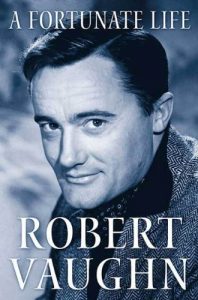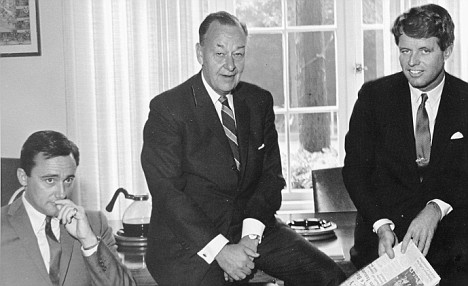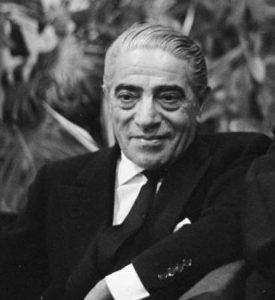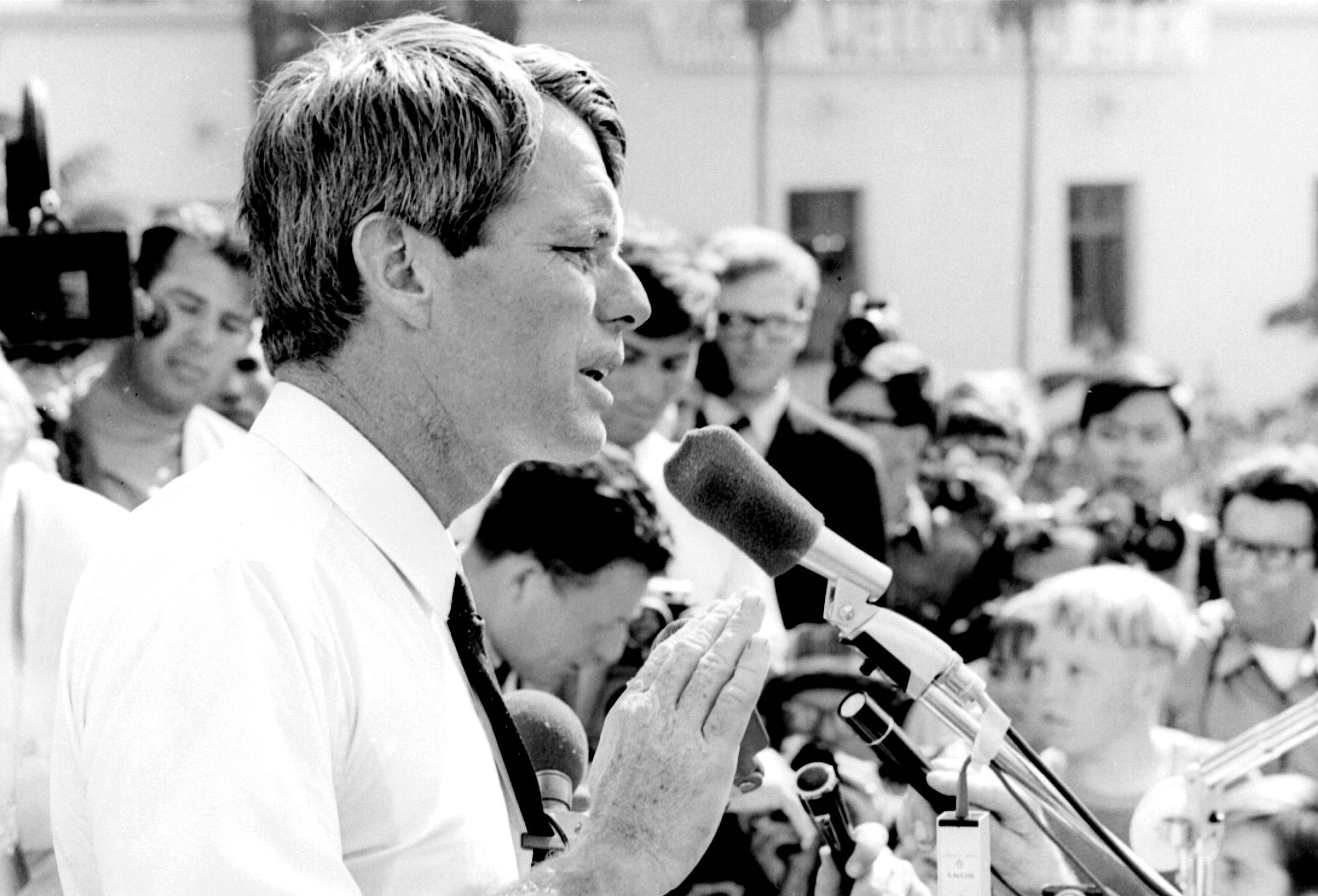Who killed Bobby Kennedy?
This is an excerpt from “A Fortunate Life,” by the late Robert Vaughn. It is published by JR Books and available for purchase at Amazon.
When Bobby Kennedy’s death was announced that day in June 1968, I cried myself to sleep. It was months before I was able to function normally again.
I had deeply admired Bobby since I was first introduced to him in 1960. Ironically, we met at the Ambassador Hotel in Los Angeles where, eight years later, he would be assassinated.
We ran into each other again at the University of Southern California in 1965, when I was concluding work on my Ph.D. in communications and my show, The Man From U.N.C.L.E., was at the height of its popularity.
 I was asked if I would host Bobby and his wife Ethel when they visited the campus for a speech.
I was asked if I would host Bobby and his wife Ethel when they visited the campus for a speech.
After that, I stayed many times at Hickory Hill, the family’s estate in Virginia, with Bobby, Ethel and their children, all big U.N.C.L.E. fans.
For years, I had been actively involved in the civil rights movement and Democratic politics, speaking out against American involvement in the Vietnam War and trying to persuade Bobby to stand against Democrat President Lyndon B. Johnson.
Indeed, a short time before Bobby announced that he would run for the Democratic nomination in 1968, he even suggested I try for a Senate seat. I was flattered.
‘When you’re sitting in the Oval Office having stopped the war, we’ll talk again,’ I said. He smiled and replied: ‘We’ll see.’ I never saw him privately again.
Like the murder of his brother John almost five years earlier, Bobby’s shooting was a watershed for America. Most people believe a lone assassin – a Palestinian refugee Sirhan Bashara Sirhan – was responsible for his death.
I shared that assumption until my continued involvement in political debate brought the real questions about Bobby’s killing to my attention.

After studying documents, talking to experts and interviewing a crucial witness, I believe there is strong evidence that Bobby’s killing was carried out by more than one gunman. And, more shockingly, that the Greek shipping magnate Aristotle Onassis paid for the assassination.
This is not to say there is no evidence linking Sirhan to the crime. He was seen by many people at the Ambassador Hotel firing his .22 pistol at Kennedy as the Senator walked through the kitchen on a shortcut between meetings.
Sirhan was arrested, charged and convicted of the crime. He was sentenced to die in the electric chair. But California abolished capital punishment in 1972 and today, 40 years on, Sirhan is still serving a life sentence.
So was Bobby Kennedy’s shooting a non-controversial, open-and-shut case with a single, obvious suspect? Here’s a summary of the facts.
Firstly, Sirhan was apparently not in the right place to fire the bullets that killed Kennedy. The autopsy shows Kennedy was shot from behind, from below, from the right and with a gun positioned no more than three inches from his head.
Yet all the eyewitnesses said they saw Sirhan between one-and-a-half and five feet in front of Kennedy – a completely different location to the one he would have needed to be into fire the fatal shots. This information was withheld until after Sirhan’s lawyers conceded his guilt.
Using the US Freedom of Information Act, Bernard Fensterwald, a Washington lawyer, obtained an FBI report on the shooting in 1976. It indicated that at least 12 bullets were fired in the hotel kitchen that evening.
Two were recovered from Bobby’s body and five from the bodies of wounded bystanders. Two more passed through Kennedy’s body, while three were found lodged in ceiling panels.

Yet the Sirhan theory relies on the notion that his gun, which held a maximum of eight bullets, was the only one fired. It just doesn’t add up.
What’s more, criminologist William Harper swore in an affidavit that the bullets that killed Kennedy could not have been fired by Sirhan’s pistol because the ballistic characteristics did not match.
Finally, there are reasons to believe the Los Angeles police obstructed or neglected aspects of the case.
For example, although an armed security guard stated he was standing behind Kennedy at the time of the shooting – the location from which the fatal shots must have come – and even admitted dropping down and pulling his gun when the shooting began, his weapon was never checked to see if he might have fired any of the bullets that killed Kennedy, whether deliberately or accidentally.
New evidence has recently come to light. Dr. Robert Joling, a past president of the American Academy of Forensic Scientists, and sound expert Philip Van Praag concluded that, based on exhaustive analysis of audio tapes from that fateful night, at least 12 shots were fired using at least two guns.
What about the mental state of Sirhan? Is it possible he could have been programmed to take the fall for Bobby’s murder?
This may sound implausible, but Dr. Herbert Spiegel, a New York psychiatrist who teaches at Columbia University and is considered an expert on hypnosis, supports this theory. He believes Sirhan was probably acting in response to hypnotic directives when he fired at Kennedy.
Sirhan appeared badly disorientated after his arrest, and when he was given a psychiatric examination before his trial, he was found to be susceptible to hypnotic suggestion, even climbing the bars of his cell like a monkey upon command.
In all probability, Dr. Spiegel suggests, Sirhan was still in a state of hypnotically induced amnesia.
These questions continue to attract interest from a few intrepid researchers. Was there a second or even a third gunman? If so, who was it? Could the security guard behind Kennedy who admitted pulling his gun have had something to do with the killing? And, assuming that more than one gunman was involved, who was the mastermind behind the plot?
Even those most eager to blame the crime on Sirhan do not pretend he had the intellect, resources or the organizational ability to pull together an assassination conspiracy.
Investigative journalist Peter Evans suggested in his 2004 book Nemesis that Onassis was responsible in part for Kennedy’s murder.

According to Evans, Onassis, and Bobby first crossed paths in 1953, when Bobby became assistant counsel to Roy Cohn, the chief investigator working for Senator Joseph McCarthy’s anti-Communist crusade.
Riddles remain over the murder of Bobby Kennedy, pictured a moment after he was shot
One of Bobby’s assignments was to study what McCarthy called the ‘blood trade’ between certain American allies and Red China, whose soldiers were fighting US troops in Korea.
Bobby found that more than 300 New York Greek shipping families were trading regularly with China. None of Onassis’s vessels was involved, but he was afraid of anyone prying into his business would discover he was secretly negotiating with Saudi Arabia to supply tankers to transport oil under the Saudi flag.
Onassis’s fears were realized in October 1953 when sealed indictments were handed down to seize any ships owned by Onassis that came into an American port. He blamed Bobby for his predicament.
Despite – or perhaps because of – his resentment of Bobby, Onassis gradually became socially and romantically entangled with the Kennedy family.
He met then-Senator John F. Kennedy and his wife Jackie in 1956 when he invited them aboard his yacht, the Christina. Shortly after JFK became President, Onassis began an affair with Lee Bouvier Radziwill, Jackie’s sister.
But Onassis wasn’t satisfied with Lee – he wanted Jackie herself. He took advantage of the First Lady’s vulnerability in August 1963, shortly after the devastating death of her two-day-old son, Patrick. Jackie accepted his invitation to stay on the Christina while she recuperated.
For Bobby, the way Onassis thrust himself into the Kennedys’ personal drama heightened the hostility between them. Onassis, of course, went on to marry Jackie in October 1968, five years after JFK’s death.
According to Evans, the notion of killing a Kennedy did not take shape in Onassis’s mind until early 1968 when he met Mahmoud Hamshari, a follower of Yasser Arafat and a fanatical anti-American and anti-Israeli activist.
Enraged by US support for Israel during the Six Day War in 1967, Hamshari suggested killing ‘a high-profile American on American soil’ would make the US government ‘think twice about backing the Jews’.
When Hamshari had an opportunity to meet Onassis, he used it to shake down the Greek magnate for money to carry out the plot.
Evans provides extensive detail about the dealings between Onassis and Hamshari. He describes the apparent involvement in the conspiracy of Dr. William Bryan, an expert in hypnosis based in Los Angeles.
He quotes a defense witness from the trial of Sirhan describing the accused killer as being ‘out of control of his consciousness and his own actions [and] subject to bizarre disassociated trances in some of which he programmed himself to be the instrument of assassination’.
And he describes pages from Sirhan’s notebook, once in the possession of Christina Onassis, that seem to implicate Onassis not just in Bobby’s killing but also in two other business-related murders.
Then there is Hélène Gaillet, one of the players in Evans’s story, whom I have interviewed myself. On an autumn afternoon in 2007, I met Helene at her apartment on New York’s Upper West Side.
Statuesque and elegant, Hélène had worked as a photographer for The New York Times and New York magazine.
Hélène met Onassis for the first time at the Coach House restaurant in New York in the early Seventies. As the dinner came to a close, he raised the palms of her hands to his lips and said: ‘The next time you are in Paris and need a place to stay, call me.’
In 1973, she was due to cover the fight between George Foreman and Muhammad Ali in Zaire. But when it was postponed for a month, she found herself in Paris with time on her hands.
Hélène remembered Onassis’s invitation and called him. Fifteen minutes later, he invited her to his estate on the Greek island of Skorpios.
Onassis’s daughter Christina was there. She was worried about her father’s welfare and made Hélène promise not to take any pictures of him. Onassis was dealing with some difficult business issues, Christina said, and she was worried that any unflattering pictures would make him more vulnerable to his enemies.
During her visit to Skorpios, Hélène stayed on Onassis’s yacht while he remained at his estate. One day, they went skinny-dipping and he came on to her. Helene reciprocated enthusiastically. It was the first and last time that happened between them.
A few days later, Hélène dined with Onassis at his beach house. They talked about many things, including religion. Hélène had been raised a Catholic and Ari questioned her closely, saying he was fascinated by confession and absolution.
In the course of the conversation, she asked Ari whether he agreed with Hemingway’s famous remark about the difference between rich people and the rest of us – ‘They have more money’.
With a laugh, Onassis replied: ‘The rich get laid more, I know that … Even that little runt Bobby Kennedy got laid more.’
More disturbingly, Onassis went on to speak freely about Bobby. According to Hélène, Onassis’s hatred for him was still vivid and intense.
In the small hours, Onassis walked Helene to the beach from where a launch would take her back to the Christina. They stood together, gazing out to sea, for a long time.
After a while, Hélène realized Onassis was talking to himself, in low, murmuring tones, like someone deep in prayer.
Finally, as she strained to hear what he was saying, he turned to her and, clearly and simply, said: ‘You know, Hélène, I put up the money for Bobby Kennedy’s murder.’
I spent almost two hours with Hélène at her apartment. I was most impressed with her ability to place herself in the time and emotions of some of the world’s most powerful and famous people and her conversations with them.
Not once did I feel that Hélène, now in her 70s, was anything but honest. I’m convinced her story is a faithful rendition of what happened to her.
Does Hélène’s story settle forever the question of who killed Bobby Kennedy? Not in a legal sense and perhaps not even in a moral sense. But along with the other evidence, it makes abundantly clear that one of the greatest crimes of the 20th Century remains unresolved by the official verdict, even to this day.

Baltimore Post-Examiner is run by a creative cadre of dedicated journalists – some who worked at the Washington Post, Baltimore Examiner and other regional and national publications. It’s the Post-Examiner because we love the play on the word “Post” but we are also hoping to answer that question: What’s next after newspapers? We see a lot of websites come and go – and many simply are not making it for various reasons. We have been a model of success since we launched in 2012 with “a little bit of everything” and we aim to continue to break that cycle of websites coming and going.

